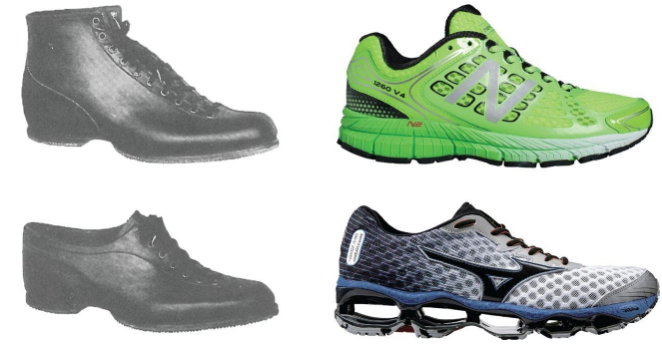


The purpose of this blog is to discuss how we came to the modern shoe today; vibrant colorways, cushion, fancy laces, and so on. I also want to discuss how the shoe industry has done a FANTASTIC job at confusing the consumers into spending money on shoes that they feel will “fix” their foot posture during running, and how doctors and shoe companies have intertwined pain and shoe wear in the mind of the consumer.
Often times, is SO common to feel overwhelmed, confused, and distracted by flashy colors and brands when you go in the running store. Of course we all love shoes that “look cool”, or I have heard many runners who match their shoe to their outfit. We can get sidetracked and end up picking a shoe that has too many bells and whistles, when really we just want something between our precious feet and the road. My goal of providing this information is for more people to have basic knowledge of why shoes are the way they are today, and what basic things you need to remember when shopping for shoes.
This is a more historical version and in-depth version of our PAIN FREE RUNNING GUIDE, that you can download HERE.
From Clod Hoppers to Frog Feet: A Quick History
There is a beautiful side-by-side of what running shoes were in 1912 and what they have evolved into now in 21st century. You think that your feet take a beating now? We have slowly developed shoes to be softer and more cushioned, to the point where some people describe shoes as “running on clouds”.
In the mid-70s podiatrists gathered and discussed why they thought runners had so many ankle, foot, and knee injuries. They collectively decided it HAD to be due to too much impact or pronation (2). They also decided to give shoe recommendations based on foot shape, and this continues today. The industry continued to not only be shaped by the conjecture of doctors but of the popularization of running shoe fashion, including the building of brands such as Adidas and Nike.
As you can see, things such as non-science related like book publishings (loved Born to Run) greatly impacted the way shoes were being discussed and used in the general population. It turned out that as soon as Born to Run came out everyone wanted minimalist shoes, and did not properly transition from their previous cushion shoes (2). Not allowing your muscles and bones to gradually build up resilience to less cushion lead to injuries, where it is now commonly understood that if you transition types of shoes you must follow a transition. Unfortunately, non-evidence based publications like these led people to be more confused than they were before about what they really should be wearing, or how to transition into what they wanted to wear.
Matching Cinderella’s flat foot to the glass slipper: does it prevent injury?
To this day, many individuals still correlate foot dysfunctions to footwear, and assume that with a specific foot shape they need a specific shoe. This partially has to do with the original podiatrists who believed that poor foot mechanics and foot posture were the root cause of injuries, and therefore shoes were made to accommodate those movements or prevent them from occurring at all. However, the research tends to point towards the opposite direction and that wearing a certain particular shoe has no relationship and correlation towards decreasing injuries.
There was a large study conducted with the U.S. Military where over 1,000 individuals were assessed for foot type according to these examples (3-5):
If you have high arched feet? ——> You need a cushioned shoe,
If you have flat arches? ——> Your feet need some support with rigid insoles and a motion control shoe.
If you fit in neither of these categories and just have a deemed “medium” arch? ——> Try out a stability shoe.
Even though each individual was matched to their prescribed shoe based on what the industry understood at the time, it DID NOT predict injury risk and did not prevent injury regardless of gender or foot type (3-5). This reinforces the current understanding that to prevent pain and injury, a shoe is not going to be the band-aid to fix these problems. Adequate preparation, proper training, load management, and recovery are the keys to a successful running program. We have come to understand that pain and injury are much more complex than a simple shoe prescription. It is a matter a person’s training, life, beliefs, and so on.
While the latest technology, designs, and cool colorways may all seem alluring and “sexy”, the number one thing that reigns supreme in terms of finding the best running shoe will be COMFORT. Having a comfortable shoe will allow you to spend more time on your feet for longer, better runs. So experiment! Try out a range of shoes ranging anywhere from the high arch support cushioned Hokas to the minimalistic shoes! With this knowledge, I hope you have a bit more understand of what you should look for the next time you head to your favorite store to pick up a new pair of running shoes!
Nigg B, Baltich J, Hoerzer S, et al. Running shoes and running injuries: mythbusting and a proposal for two new paradigms: ‘preferred movement path’ and ‘comfort filter’. Br. J. Sports Med. 2015;49:1290-1294.
Disclaimer: This blog is not medical advice, if you are experiencing pain you should consult a local healthcare provider.

0

0
Comments :